Case Study: HRM Strategies & Challenges in Indian Call Centres
VerifiedAdded on 2023/06/09
|14
|3423
|140
Case Study
AI Summary
This case study examines the challenges and potential solutions for Human Resource Management (HRM) within Indian call centres. Initially promising significant economic growth, the Indian call centre industry faced issues such as poor service quality, high employee turnover, and stressful working conditions. The report identifies general and specific HR strategies, including recruitment, training, compensation, talent management, and motivation, as crucial for addressing these problems. Solutions proposed include ensuring compliance with fair work practices, improving employee knowledge and skills through training, enhancing customer service by hiring suitable candidates, and effectively managing Service Level Agreements (SLAs). The ultimate goal is to improve the overall performance and sustainability of Indian call centres by focusing on strategic HRM practices.

qwertyuiopasdfghjklzxcvbnmqw
ertyuiopasdfghjklzxcvbnmqwert
yuiopasdfghjklzxcvbnmqwertyui
opasdfghjklzxcvbnmqwertyuiop
asdfghjklzxcvbnmqwertyuiopasd
fghjklzxcvbnmqwertyuiopasdfgh
jklzxcvbnmqwertyuiopasdfghjkl
zxcvbnmqwertyuiopasdfghjklzxc
vbnmqwertyuiopasdfghjklzxcvb
nmqwertyuiopasdfghjklzxcvbnm
qwertyuiopasdfghjklzxcvbnmqw
ertyuiopasdfghjklzxcvbnmqwert
yuiopasdfghjklzxcvbnmqwertyui
opasdfghjklzxcvbnmqwertyuiop
asdfghjklzxcvbnmqwertyuiopasd
fghjklzxcvbnmqwertyuiopasdfgh
jklzxcvbnmrtyuiopasdfghjklzxcv
Human Resource Management: Report
ertyuiopasdfghjklzxcvbnmqwert
yuiopasdfghjklzxcvbnmqwertyui
opasdfghjklzxcvbnmqwertyuiop
asdfghjklzxcvbnmqwertyuiopasd
fghjklzxcvbnmqwertyuiopasdfgh
jklzxcvbnmqwertyuiopasdfghjkl
zxcvbnmqwertyuiopasdfghjklzxc
vbnmqwertyuiopasdfghjklzxcvb
nmqwertyuiopasdfghjklzxcvbnm
qwertyuiopasdfghjklzxcvbnmqw
ertyuiopasdfghjklzxcvbnmqwert
yuiopasdfghjklzxcvbnmqwertyui
opasdfghjklzxcvbnmqwertyuiop
asdfghjklzxcvbnmqwertyuiopasd
fghjklzxcvbnmqwertyuiopasdfgh
jklzxcvbnmrtyuiopasdfghjklzxcv
Human Resource Management: Report
Paraphrase This Document
Need a fresh take? Get an instant paraphrase of this document with our AI Paraphraser
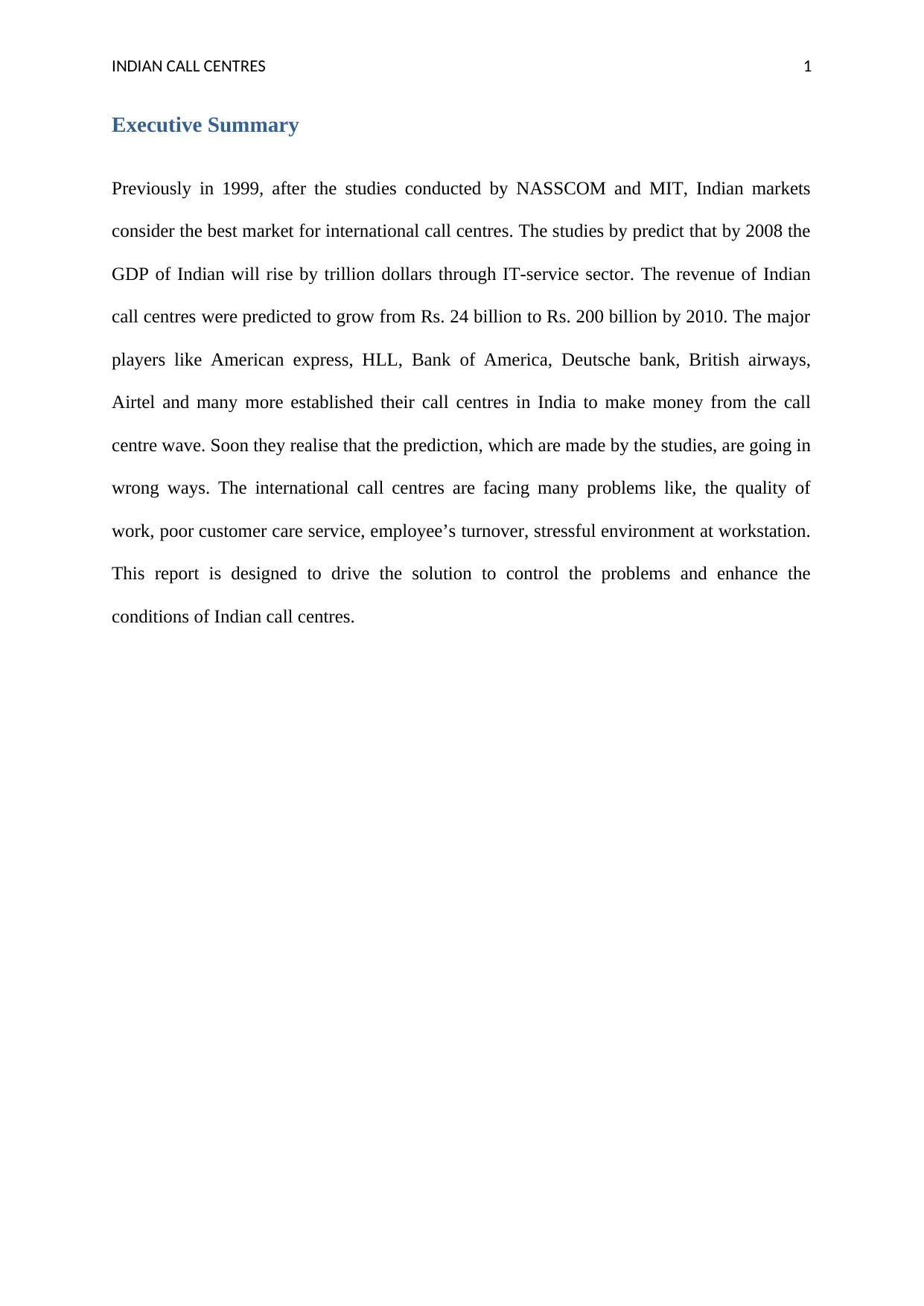
INDIAN CALL CENTRES 1
Executive Summary
Previously in 1999, after the studies conducted by NASSCOM and MIT, Indian markets
consider the best market for international call centres. The studies by predict that by 2008 the
GDP of Indian will rise by trillion dollars through IT-service sector. The revenue of Indian
call centres were predicted to grow from Rs. 24 billion to Rs. 200 billion by 2010. The major
players like American express, HLL, Bank of America, Deutsche bank, British airways,
Airtel and many more established their call centres in India to make money from the call
centre wave. Soon they realise that the prediction, which are made by the studies, are going in
wrong ways. The international call centres are facing many problems like, the quality of
work, poor customer care service, employee’s turnover, stressful environment at workstation.
This report is designed to drive the solution to control the problems and enhance the
conditions of Indian call centres.
Executive Summary
Previously in 1999, after the studies conducted by NASSCOM and MIT, Indian markets
consider the best market for international call centres. The studies by predict that by 2008 the
GDP of Indian will rise by trillion dollars through IT-service sector. The revenue of Indian
call centres were predicted to grow from Rs. 24 billion to Rs. 200 billion by 2010. The major
players like American express, HLL, Bank of America, Deutsche bank, British airways,
Airtel and many more established their call centres in India to make money from the call
centre wave. Soon they realise that the prediction, which are made by the studies, are going in
wrong ways. The international call centres are facing many problems like, the quality of
work, poor customer care service, employee’s turnover, stressful environment at workstation.
This report is designed to drive the solution to control the problems and enhance the
conditions of Indian call centres.
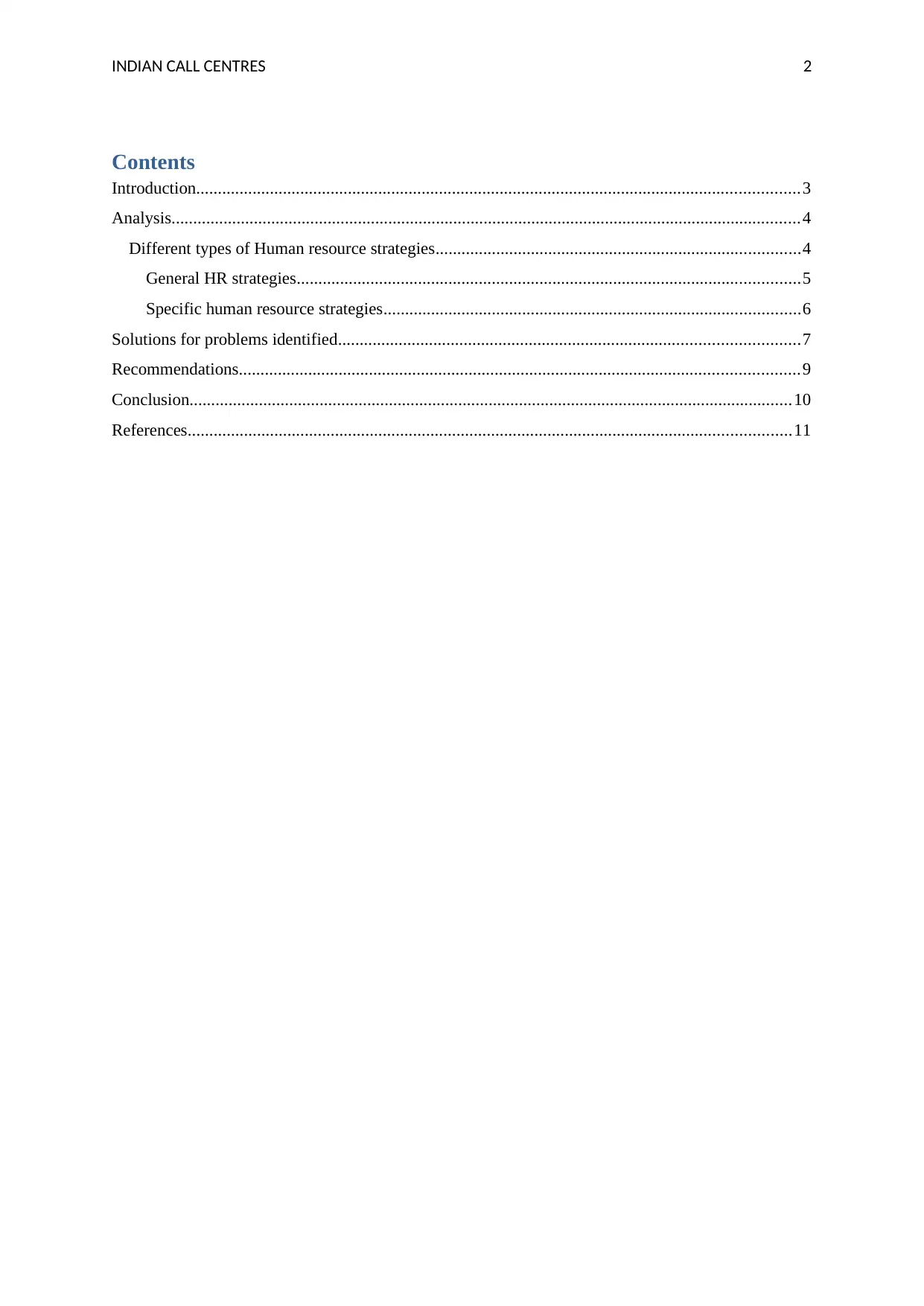
INDIAN CALL CENTRES 2
Contents
Introduction...........................................................................................................................................3
Analysis.................................................................................................................................................4
Different types of Human resource strategies....................................................................................4
General HR strategies....................................................................................................................5
Specific human resource strategies................................................................................................6
Solutions for problems identified..........................................................................................................7
Recommendations.................................................................................................................................9
Conclusion...........................................................................................................................................10
References...........................................................................................................................................11
Contents
Introduction...........................................................................................................................................3
Analysis.................................................................................................................................................4
Different types of Human resource strategies....................................................................................4
General HR strategies....................................................................................................................5
Specific human resource strategies................................................................................................6
Solutions for problems identified..........................................................................................................7
Recommendations.................................................................................................................................9
Conclusion...........................................................................................................................................10
References...........................................................................................................................................11
⊘ This is a preview!⊘
Do you want full access?
Subscribe today to unlock all pages.

Trusted by 1+ million students worldwide
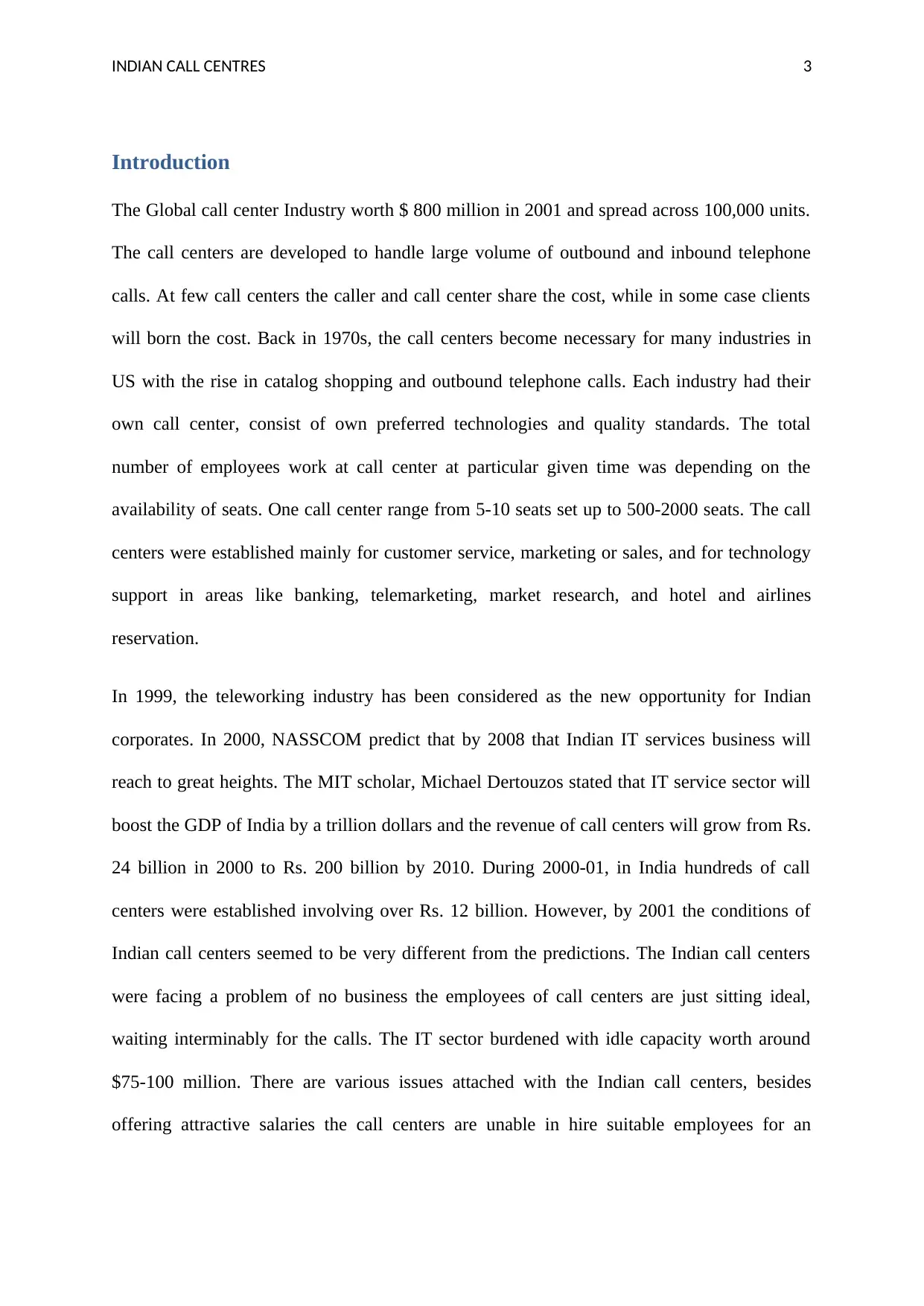
INDIAN CALL CENTRES 3
Introduction
The Global call center Industry worth $ 800 million in 2001 and spread across 100,000 units.
The call centers are developed to handle large volume of outbound and inbound telephone
calls. At few call centers the caller and call center share the cost, while in some case clients
will born the cost. Back in 1970s, the call centers become necessary for many industries in
US with the rise in catalog shopping and outbound telephone calls. Each industry had their
own call center, consist of own preferred technologies and quality standards. The total
number of employees work at call center at particular given time was depending on the
availability of seats. One call center range from 5-10 seats set up to 500-2000 seats. The call
centers were established mainly for customer service, marketing or sales, and for technology
support in areas like banking, telemarketing, market research, and hotel and airlines
reservation.
In 1999, the teleworking industry has been considered as the new opportunity for Indian
corporates. In 2000, NASSCOM predict that by 2008 that Indian IT services business will
reach to great heights. The MIT scholar, Michael Dertouzos stated that IT service sector will
boost the GDP of India by a trillion dollars and the revenue of call centers will grow from Rs.
24 billion in 2000 to Rs. 200 billion by 2010. During 2000-01, in India hundreds of call
centers were established involving over Rs. 12 billion. However, by 2001 the conditions of
Indian call centers seemed to be very different from the predictions. The Indian call centers
were facing a problem of no business the employees of call centers are just sitting ideal,
waiting interminably for the calls. The IT sector burdened with idle capacity worth around
$75-100 million. There are various issues attached with the Indian call centers, besides
offering attractive salaries the call centers are unable in hire suitable employees for an
Introduction
The Global call center Industry worth $ 800 million in 2001 and spread across 100,000 units.
The call centers are developed to handle large volume of outbound and inbound telephone
calls. At few call centers the caller and call center share the cost, while in some case clients
will born the cost. Back in 1970s, the call centers become necessary for many industries in
US with the rise in catalog shopping and outbound telephone calls. Each industry had their
own call center, consist of own preferred technologies and quality standards. The total
number of employees work at call center at particular given time was depending on the
availability of seats. One call center range from 5-10 seats set up to 500-2000 seats. The call
centers were established mainly for customer service, marketing or sales, and for technology
support in areas like banking, telemarketing, market research, and hotel and airlines
reservation.
In 1999, the teleworking industry has been considered as the new opportunity for Indian
corporates. In 2000, NASSCOM predict that by 2008 that Indian IT services business will
reach to great heights. The MIT scholar, Michael Dertouzos stated that IT service sector will
boost the GDP of India by a trillion dollars and the revenue of call centers will grow from Rs.
24 billion in 2000 to Rs. 200 billion by 2010. During 2000-01, in India hundreds of call
centers were established involving over Rs. 12 billion. However, by 2001 the conditions of
Indian call centers seemed to be very different from the predictions. The Indian call centers
were facing a problem of no business the employees of call centers are just sitting ideal,
waiting interminably for the calls. The IT sector burdened with idle capacity worth around
$75-100 million. There are various issues attached with the Indian call centers, besides
offering attractive salaries the call centers are unable in hire suitable employees for an
Paraphrase This Document
Need a fresh take? Get an instant paraphrase of this document with our AI Paraphraser
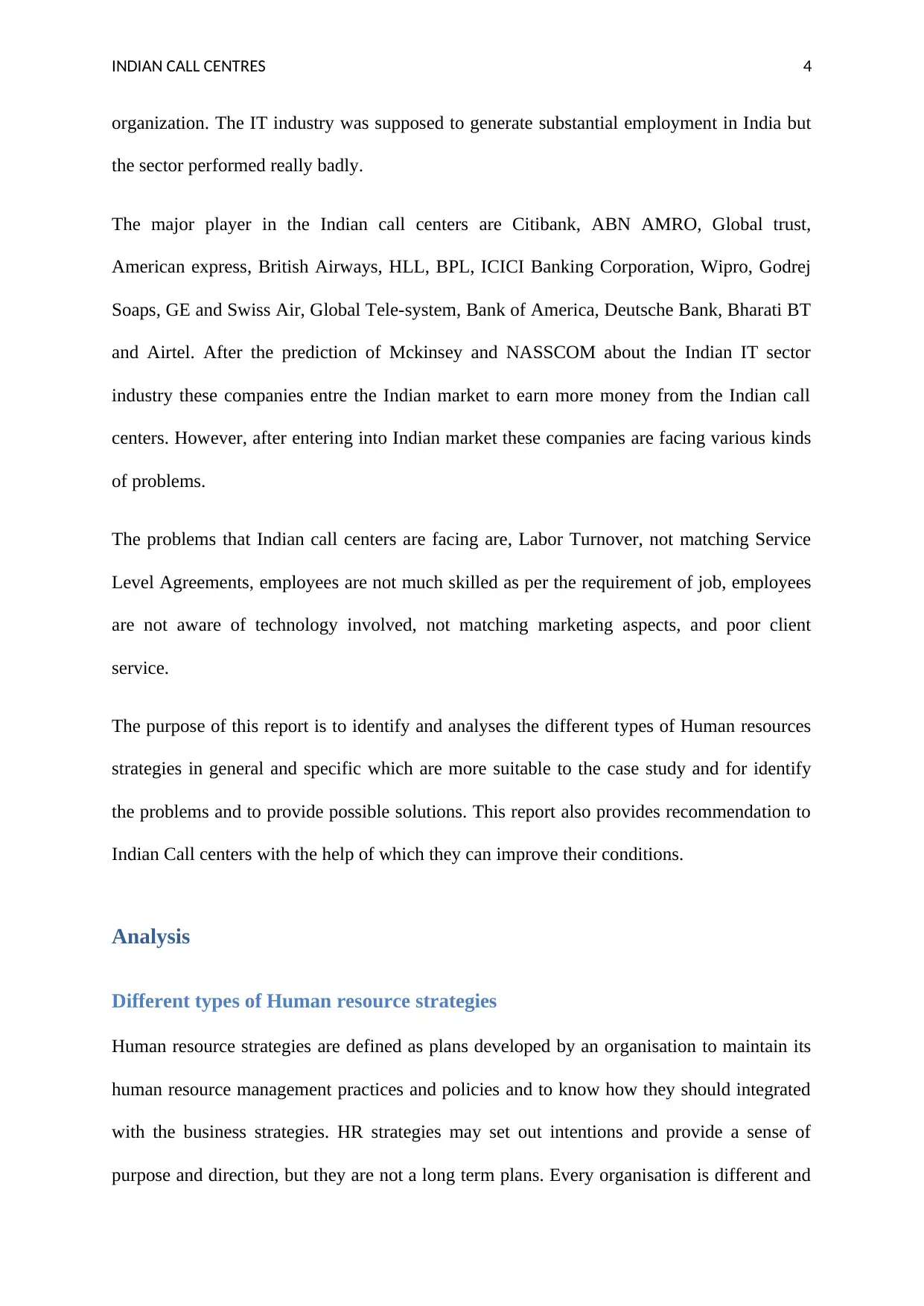
INDIAN CALL CENTRES 4
organization. The IT industry was supposed to generate substantial employment in India but
the sector performed really badly.
The major player in the Indian call centers are Citibank, ABN AMRO, Global trust,
American express, British Airways, HLL, BPL, ICICI Banking Corporation, Wipro, Godrej
Soaps, GE and Swiss Air, Global Tele-system, Bank of America, Deutsche Bank, Bharati BT
and Airtel. After the prediction of Mckinsey and NASSCOM about the Indian IT sector
industry these companies entre the Indian market to earn more money from the Indian call
centers. However, after entering into Indian market these companies are facing various kinds
of problems.
The problems that Indian call centers are facing are, Labor Turnover, not matching Service
Level Agreements, employees are not much skilled as per the requirement of job, employees
are not aware of technology involved, not matching marketing aspects, and poor client
service.
The purpose of this report is to identify and analyses the different types of Human resources
strategies in general and specific which are more suitable to the case study and for identify
the problems and to provide possible solutions. This report also provides recommendation to
Indian Call centers with the help of which they can improve their conditions.
Analysis
Different types of Human resource strategies
Human resource strategies are defined as plans developed by an organisation to maintain its
human resource management practices and policies and to know how they should integrated
with the business strategies. HR strategies may set out intentions and provide a sense of
purpose and direction, but they are not a long term plans. Every organisation is different and
organization. The IT industry was supposed to generate substantial employment in India but
the sector performed really badly.
The major player in the Indian call centers are Citibank, ABN AMRO, Global trust,
American express, British Airways, HLL, BPL, ICICI Banking Corporation, Wipro, Godrej
Soaps, GE and Swiss Air, Global Tele-system, Bank of America, Deutsche Bank, Bharati BT
and Airtel. After the prediction of Mckinsey and NASSCOM about the Indian IT sector
industry these companies entre the Indian market to earn more money from the Indian call
centers. However, after entering into Indian market these companies are facing various kinds
of problems.
The problems that Indian call centers are facing are, Labor Turnover, not matching Service
Level Agreements, employees are not much skilled as per the requirement of job, employees
are not aware of technology involved, not matching marketing aspects, and poor client
service.
The purpose of this report is to identify and analyses the different types of Human resources
strategies in general and specific which are more suitable to the case study and for identify
the problems and to provide possible solutions. This report also provides recommendation to
Indian Call centers with the help of which they can improve their conditions.
Analysis
Different types of Human resource strategies
Human resource strategies are defined as plans developed by an organisation to maintain its
human resource management practices and policies and to know how they should integrated
with the business strategies. HR strategies may set out intentions and provide a sense of
purpose and direction, but they are not a long term plans. Every organisation is different and
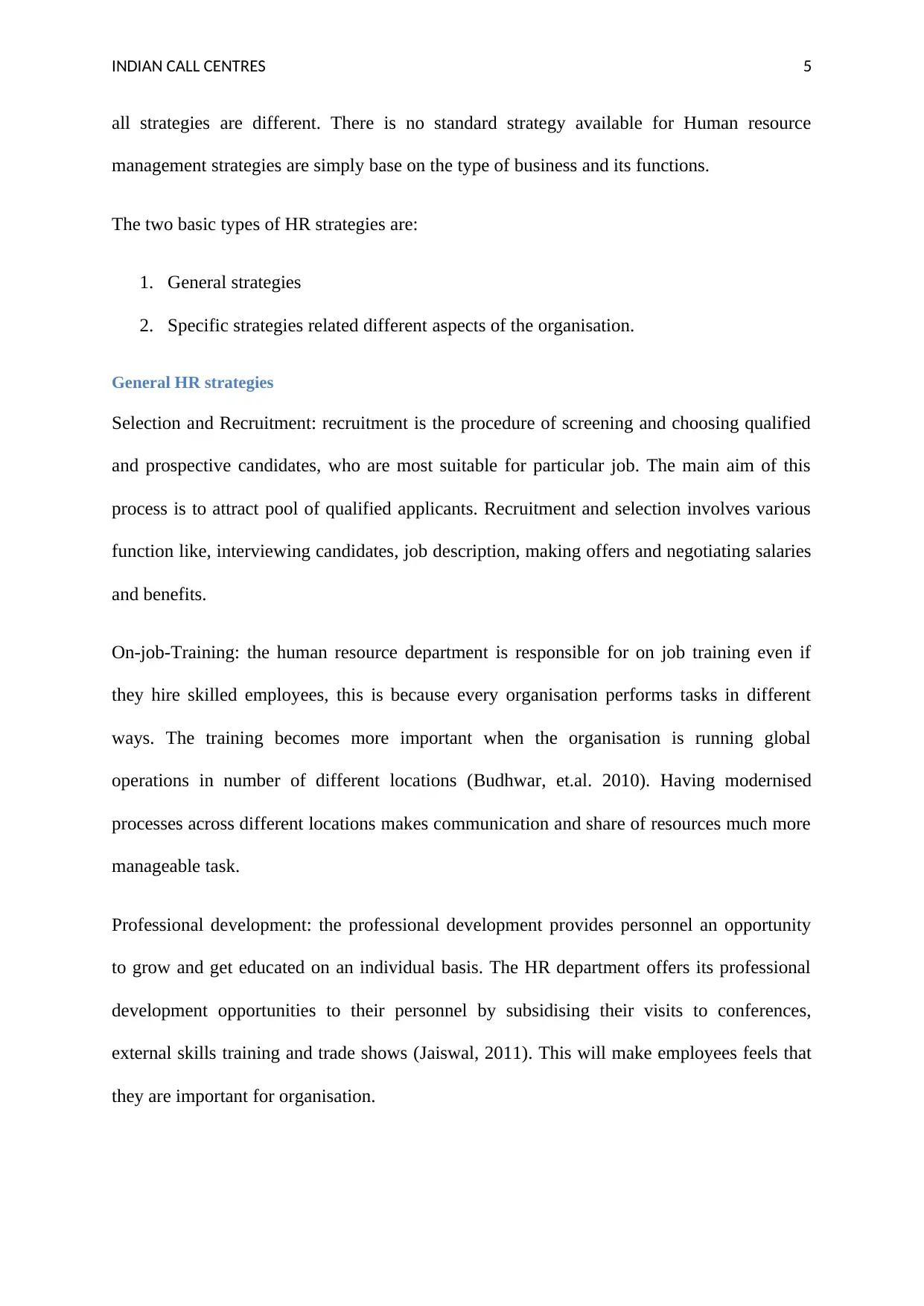
INDIAN CALL CENTRES 5
all strategies are different. There is no standard strategy available for Human resource
management strategies are simply base on the type of business and its functions.
The two basic types of HR strategies are:
1. General strategies
2. Specific strategies related different aspects of the organisation.
General HR strategies
Selection and Recruitment: recruitment is the procedure of screening and choosing qualified
and prospective candidates, who are most suitable for particular job. The main aim of this
process is to attract pool of qualified applicants. Recruitment and selection involves various
function like, interviewing candidates, job description, making offers and negotiating salaries
and benefits.
On-job-Training: the human resource department is responsible for on job training even if
they hire skilled employees, this is because every organisation performs tasks in different
ways. The training becomes more important when the organisation is running global
operations in number of different locations (Budhwar, et.al. 2010). Having modernised
processes across different locations makes communication and share of resources much more
manageable task.
Professional development: the professional development provides personnel an opportunity
to grow and get educated on an individual basis. The HR department offers its professional
development opportunities to their personnel by subsidising their visits to conferences,
external skills training and trade shows (Jaiswal, 2011). This will make employees feels that
they are important for organisation.
all strategies are different. There is no standard strategy available for Human resource
management strategies are simply base on the type of business and its functions.
The two basic types of HR strategies are:
1. General strategies
2. Specific strategies related different aspects of the organisation.
General HR strategies
Selection and Recruitment: recruitment is the procedure of screening and choosing qualified
and prospective candidates, who are most suitable for particular job. The main aim of this
process is to attract pool of qualified applicants. Recruitment and selection involves various
function like, interviewing candidates, job description, making offers and negotiating salaries
and benefits.
On-job-Training: the human resource department is responsible for on job training even if
they hire skilled employees, this is because every organisation performs tasks in different
ways. The training becomes more important when the organisation is running global
operations in number of different locations (Budhwar, et.al. 2010). Having modernised
processes across different locations makes communication and share of resources much more
manageable task.
Professional development: the professional development provides personnel an opportunity
to grow and get educated on an individual basis. The HR department offers its professional
development opportunities to their personnel by subsidising their visits to conferences,
external skills training and trade shows (Jaiswal, 2011). This will make employees feels that
they are important for organisation.
⊘ This is a preview!⊘
Do you want full access?
Subscribe today to unlock all pages.

Trusted by 1+ million students worldwide
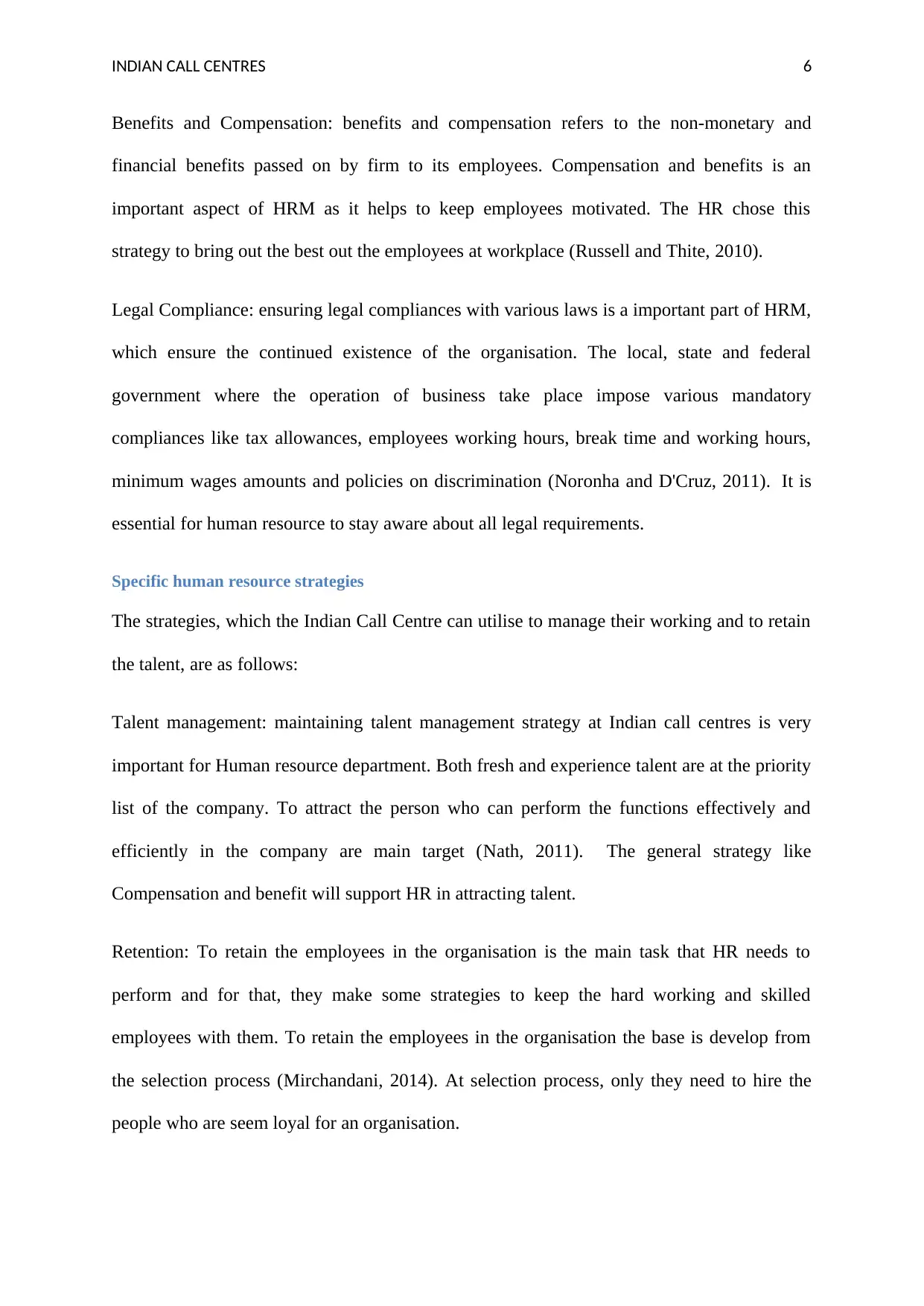
INDIAN CALL CENTRES 6
Benefits and Compensation: benefits and compensation refers to the non-monetary and
financial benefits passed on by firm to its employees. Compensation and benefits is an
important aspect of HRM as it helps to keep employees motivated. The HR chose this
strategy to bring out the best out the employees at workplace (Russell and Thite, 2010).
Legal Compliance: ensuring legal compliances with various laws is a important part of HRM,
which ensure the continued existence of the organisation. The local, state and federal
government where the operation of business take place impose various mandatory
compliances like tax allowances, employees working hours, break time and working hours,
minimum wages amounts and policies on discrimination (Noronha and D'Cruz, 2011). It is
essential for human resource to stay aware about all legal requirements.
Specific human resource strategies
The strategies, which the Indian Call Centre can utilise to manage their working and to retain
the talent, are as follows:
Talent management: maintaining talent management strategy at Indian call centres is very
important for Human resource department. Both fresh and experience talent are at the priority
list of the company. To attract the person who can perform the functions effectively and
efficiently in the company are main target (Nath, 2011). The general strategy like
Compensation and benefit will support HR in attracting talent.
Retention: To retain the employees in the organisation is the main task that HR needs to
perform and for that, they make some strategies to keep the hard working and skilled
employees with them. To retain the employees in the organisation the base is develop from
the selection process (Mirchandani, 2014). At selection process, only they need to hire the
people who are seem loyal for an organisation.
Benefits and Compensation: benefits and compensation refers to the non-monetary and
financial benefits passed on by firm to its employees. Compensation and benefits is an
important aspect of HRM as it helps to keep employees motivated. The HR chose this
strategy to bring out the best out the employees at workplace (Russell and Thite, 2010).
Legal Compliance: ensuring legal compliances with various laws is a important part of HRM,
which ensure the continued existence of the organisation. The local, state and federal
government where the operation of business take place impose various mandatory
compliances like tax allowances, employees working hours, break time and working hours,
minimum wages amounts and policies on discrimination (Noronha and D'Cruz, 2011). It is
essential for human resource to stay aware about all legal requirements.
Specific human resource strategies
The strategies, which the Indian Call Centre can utilise to manage their working and to retain
the talent, are as follows:
Talent management: maintaining talent management strategy at Indian call centres is very
important for Human resource department. Both fresh and experience talent are at the priority
list of the company. To attract the person who can perform the functions effectively and
efficiently in the company are main target (Nath, 2011). The general strategy like
Compensation and benefit will support HR in attracting talent.
Retention: To retain the employees in the organisation is the main task that HR needs to
perform and for that, they make some strategies to keep the hard working and skilled
employees with them. To retain the employees in the organisation the base is develop from
the selection process (Mirchandani, 2014). At selection process, only they need to hire the
people who are seem loyal for an organisation.
Paraphrase This Document
Need a fresh take? Get an instant paraphrase of this document with our AI Paraphraser
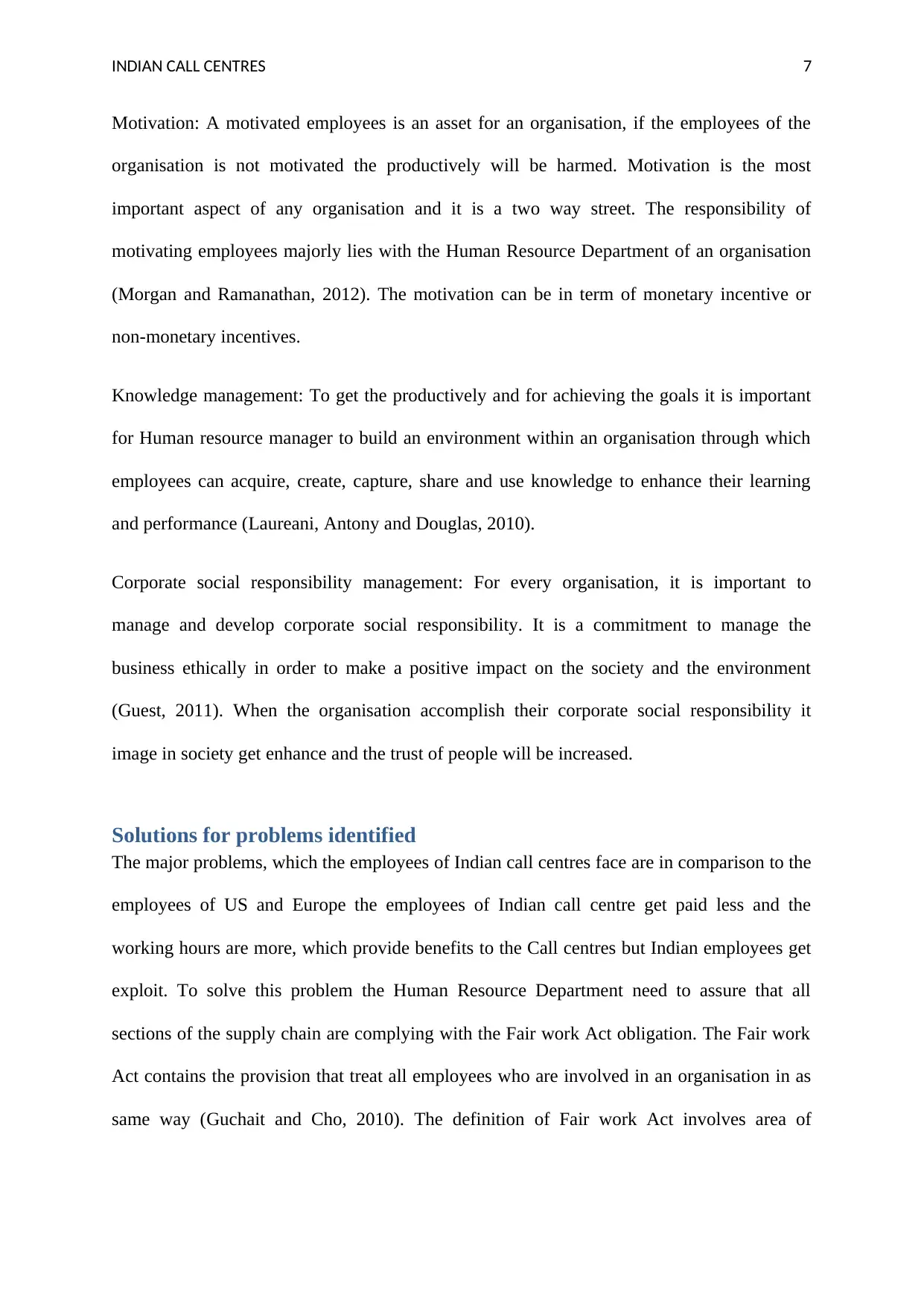
INDIAN CALL CENTRES 7
Motivation: A motivated employees is an asset for an organisation, if the employees of the
organisation is not motivated the productively will be harmed. Motivation is the most
important aspect of any organisation and it is a two way street. The responsibility of
motivating employees majorly lies with the Human Resource Department of an organisation
(Morgan and Ramanathan, 2012). The motivation can be in term of monetary incentive or
non-monetary incentives.
Knowledge management: To get the productively and for achieving the goals it is important
for Human resource manager to build an environment within an organisation through which
employees can acquire, create, capture, share and use knowledge to enhance their learning
and performance (Laureani, Antony and Douglas, 2010).
Corporate social responsibility management: For every organisation, it is important to
manage and develop corporate social responsibility. It is a commitment to manage the
business ethically in order to make a positive impact on the society and the environment
(Guest, 2011). When the organisation accomplish their corporate social responsibility it
image in society get enhance and the trust of people will be increased.
Solutions for problems identified
The major problems, which the employees of Indian call centres face are in comparison to the
employees of US and Europe the employees of Indian call centre get paid less and the
working hours are more, which provide benefits to the Call centres but Indian employees get
exploit. To solve this problem the Human Resource Department need to assure that all
sections of the supply chain are complying with the Fair work Act obligation. The Fair work
Act contains the provision that treat all employees who are involved in an organisation in as
same way (Guchait and Cho, 2010). The definition of Fair work Act involves area of
Motivation: A motivated employees is an asset for an organisation, if the employees of the
organisation is not motivated the productively will be harmed. Motivation is the most
important aspect of any organisation and it is a two way street. The responsibility of
motivating employees majorly lies with the Human Resource Department of an organisation
(Morgan and Ramanathan, 2012). The motivation can be in term of monetary incentive or
non-monetary incentives.
Knowledge management: To get the productively and for achieving the goals it is important
for Human resource manager to build an environment within an organisation through which
employees can acquire, create, capture, share and use knowledge to enhance their learning
and performance (Laureani, Antony and Douglas, 2010).
Corporate social responsibility management: For every organisation, it is important to
manage and develop corporate social responsibility. It is a commitment to manage the
business ethically in order to make a positive impact on the society and the environment
(Guest, 2011). When the organisation accomplish their corporate social responsibility it
image in society get enhance and the trust of people will be increased.
Solutions for problems identified
The major problems, which the employees of Indian call centres face are in comparison to the
employees of US and Europe the employees of Indian call centre get paid less and the
working hours are more, which provide benefits to the Call centres but Indian employees get
exploit. To solve this problem the Human Resource Department need to assure that all
sections of the supply chain are complying with the Fair work Act obligation. The Fair work
Act contains the provision that treat all employees who are involved in an organisation in as
same way (Guchait and Cho, 2010). The definition of Fair work Act involves area of
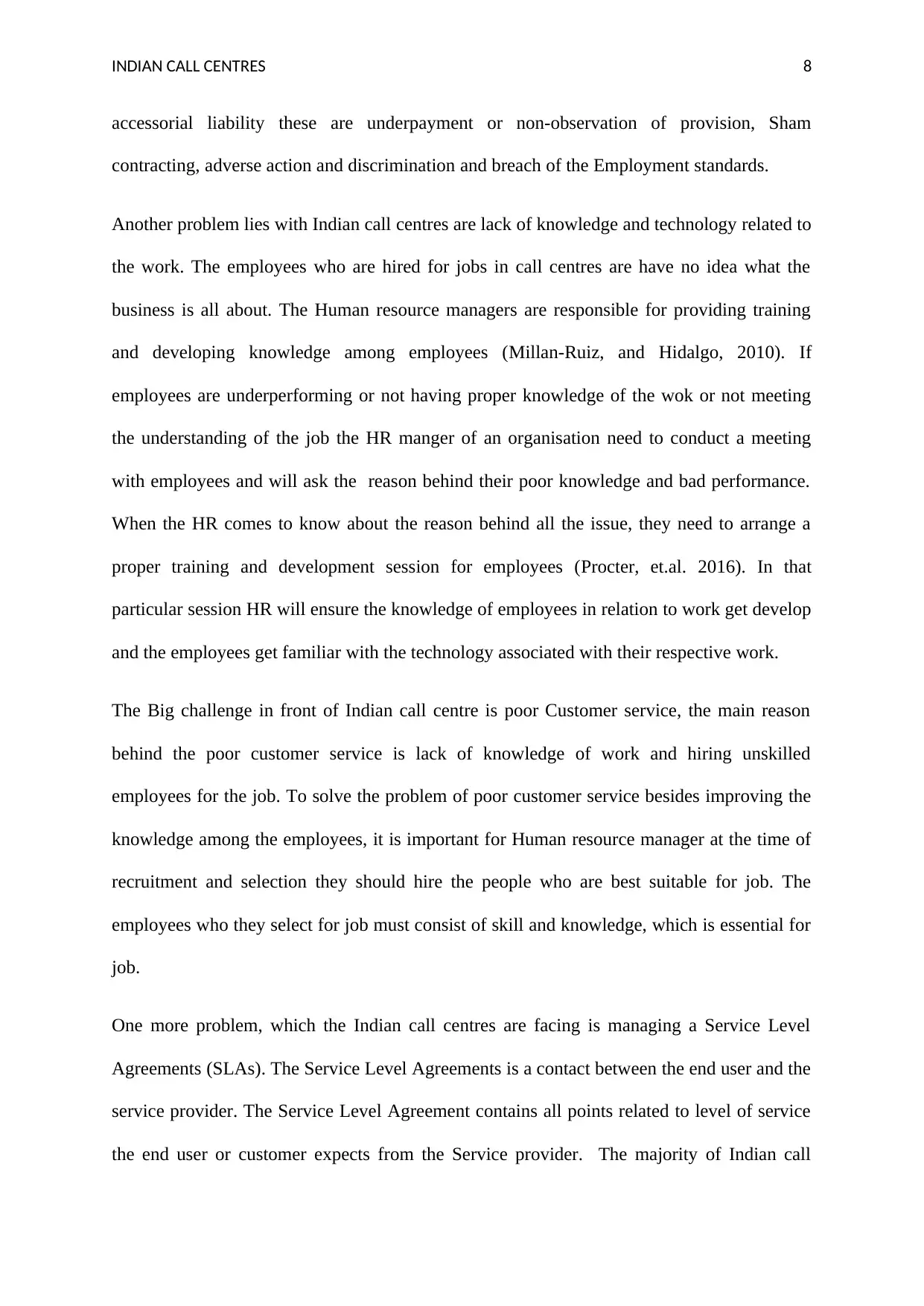
INDIAN CALL CENTRES 8
accessorial liability these are underpayment or non-observation of provision, Sham
contracting, adverse action and discrimination and breach of the Employment standards.
Another problem lies with Indian call centres are lack of knowledge and technology related to
the work. The employees who are hired for jobs in call centres are have no idea what the
business is all about. The Human resource managers are responsible for providing training
and developing knowledge among employees (Millan-Ruiz, and Hidalgo, 2010). If
employees are underperforming or not having proper knowledge of the wok or not meeting
the understanding of the job the HR manger of an organisation need to conduct a meeting
with employees and will ask the reason behind their poor knowledge and bad performance.
When the HR comes to know about the reason behind all the issue, they need to arrange a
proper training and development session for employees (Procter, et.al. 2016). In that
particular session HR will ensure the knowledge of employees in relation to work get develop
and the employees get familiar with the technology associated with their respective work.
The Big challenge in front of Indian call centre is poor Customer service, the main reason
behind the poor customer service is lack of knowledge of work and hiring unskilled
employees for the job. To solve the problem of poor customer service besides improving the
knowledge among the employees, it is important for Human resource manager at the time of
recruitment and selection they should hire the people who are best suitable for job. The
employees who they select for job must consist of skill and knowledge, which is essential for
job.
One more problem, which the Indian call centres are facing is managing a Service Level
Agreements (SLAs). The Service Level Agreements is a contact between the end user and the
service provider. The Service Level Agreement contains all points related to level of service
the end user or customer expects from the Service provider. The majority of Indian call
accessorial liability these are underpayment or non-observation of provision, Sham
contracting, adverse action and discrimination and breach of the Employment standards.
Another problem lies with Indian call centres are lack of knowledge and technology related to
the work. The employees who are hired for jobs in call centres are have no idea what the
business is all about. The Human resource managers are responsible for providing training
and developing knowledge among employees (Millan-Ruiz, and Hidalgo, 2010). If
employees are underperforming or not having proper knowledge of the wok or not meeting
the understanding of the job the HR manger of an organisation need to conduct a meeting
with employees and will ask the reason behind their poor knowledge and bad performance.
When the HR comes to know about the reason behind all the issue, they need to arrange a
proper training and development session for employees (Procter, et.al. 2016). In that
particular session HR will ensure the knowledge of employees in relation to work get develop
and the employees get familiar with the technology associated with their respective work.
The Big challenge in front of Indian call centre is poor Customer service, the main reason
behind the poor customer service is lack of knowledge of work and hiring unskilled
employees for the job. To solve the problem of poor customer service besides improving the
knowledge among the employees, it is important for Human resource manager at the time of
recruitment and selection they should hire the people who are best suitable for job. The
employees who they select for job must consist of skill and knowledge, which is essential for
job.
One more problem, which the Indian call centres are facing is managing a Service Level
Agreements (SLAs). The Service Level Agreements is a contact between the end user and the
service provider. The Service Level Agreement contains all points related to level of service
the end user or customer expects from the Service provider. The majority of Indian call
⊘ This is a preview!⊘
Do you want full access?
Subscribe today to unlock all pages.

Trusted by 1+ million students worldwide
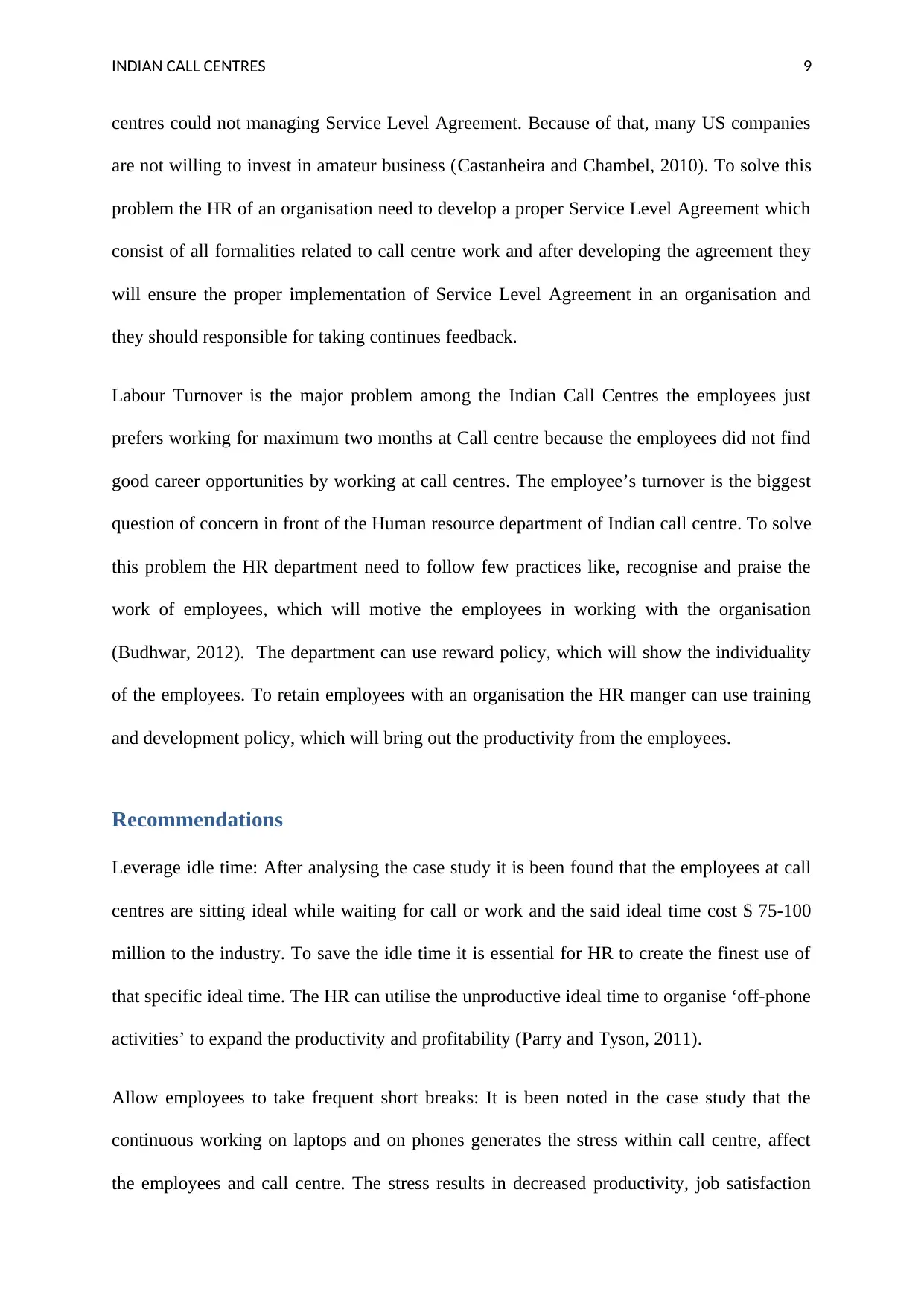
INDIAN CALL CENTRES 9
centres could not managing Service Level Agreement. Because of that, many US companies
are not willing to invest in amateur business (Castanheira and Chambel, 2010). To solve this
problem the HR of an organisation need to develop a proper Service Level Agreement which
consist of all formalities related to call centre work and after developing the agreement they
will ensure the proper implementation of Service Level Agreement in an organisation and
they should responsible for taking continues feedback.
Labour Turnover is the major problem among the Indian Call Centres the employees just
prefers working for maximum two months at Call centre because the employees did not find
good career opportunities by working at call centres. The employee’s turnover is the biggest
question of concern in front of the Human resource department of Indian call centre. To solve
this problem the HR department need to follow few practices like, recognise and praise the
work of employees, which will motive the employees in working with the organisation
(Budhwar, 2012). The department can use reward policy, which will show the individuality
of the employees. To retain employees with an organisation the HR manger can use training
and development policy, which will bring out the productivity from the employees.
Recommendations
Leverage idle time: After analysing the case study it is been found that the employees at call
centres are sitting ideal while waiting for call or work and the said ideal time cost $ 75-100
million to the industry. To save the idle time it is essential for HR to create the finest use of
that specific ideal time. The HR can utilise the unproductive ideal time to organise ‘off-phone
activities’ to expand the productivity and profitability (Parry and Tyson, 2011).
Allow employees to take frequent short breaks: It is been noted in the case study that the
continuous working on laptops and on phones generates the stress within call centre, affect
the employees and call centre. The stress results in decreased productivity, job satisfaction
centres could not managing Service Level Agreement. Because of that, many US companies
are not willing to invest in amateur business (Castanheira and Chambel, 2010). To solve this
problem the HR of an organisation need to develop a proper Service Level Agreement which
consist of all formalities related to call centre work and after developing the agreement they
will ensure the proper implementation of Service Level Agreement in an organisation and
they should responsible for taking continues feedback.
Labour Turnover is the major problem among the Indian Call Centres the employees just
prefers working for maximum two months at Call centre because the employees did not find
good career opportunities by working at call centres. The employee’s turnover is the biggest
question of concern in front of the Human resource department of Indian call centre. To solve
this problem the HR department need to follow few practices like, recognise and praise the
work of employees, which will motive the employees in working with the organisation
(Budhwar, 2012). The department can use reward policy, which will show the individuality
of the employees. To retain employees with an organisation the HR manger can use training
and development policy, which will bring out the productivity from the employees.
Recommendations
Leverage idle time: After analysing the case study it is been found that the employees at call
centres are sitting ideal while waiting for call or work and the said ideal time cost $ 75-100
million to the industry. To save the idle time it is essential for HR to create the finest use of
that specific ideal time. The HR can utilise the unproductive ideal time to organise ‘off-phone
activities’ to expand the productivity and profitability (Parry and Tyson, 2011).
Allow employees to take frequent short breaks: It is been noted in the case study that the
continuous working on laptops and on phones generates the stress within call centre, affect
the employees and call centre. The stress results in decreased productivity, job satisfaction
Paraphrase This Document
Need a fresh take? Get an instant paraphrase of this document with our AI Paraphraser
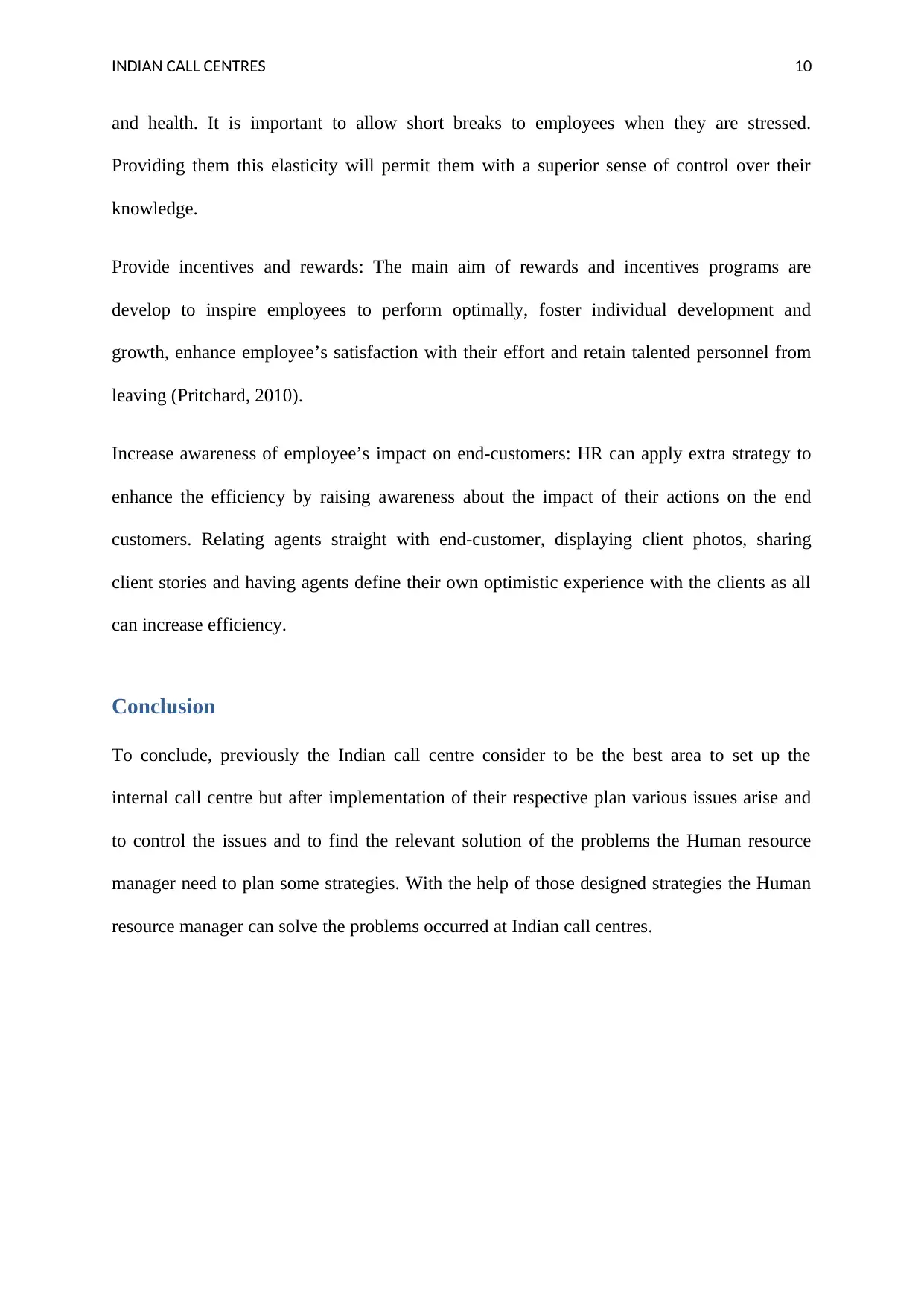
INDIAN CALL CENTRES 10
and health. It is important to allow short breaks to employees when they are stressed.
Providing them this elasticity will permit them with a superior sense of control over their
knowledge.
Provide incentives and rewards: The main aim of rewards and incentives programs are
develop to inspire employees to perform optimally, foster individual development and
growth, enhance employee’s satisfaction with their effort and retain talented personnel from
leaving (Pritchard, 2010).
Increase awareness of employee’s impact on end-customers: HR can apply extra strategy to
enhance the efficiency by raising awareness about the impact of their actions on the end
customers. Relating agents straight with end-customer, displaying client photos, sharing
client stories and having agents define their own optimistic experience with the clients as all
can increase efficiency.
Conclusion
To conclude, previously the Indian call centre consider to be the best area to set up the
internal call centre but after implementation of their respective plan various issues arise and
to control the issues and to find the relevant solution of the problems the Human resource
manager need to plan some strategies. With the help of those designed strategies the Human
resource manager can solve the problems occurred at Indian call centres.
and health. It is important to allow short breaks to employees when they are stressed.
Providing them this elasticity will permit them with a superior sense of control over their
knowledge.
Provide incentives and rewards: The main aim of rewards and incentives programs are
develop to inspire employees to perform optimally, foster individual development and
growth, enhance employee’s satisfaction with their effort and retain talented personnel from
leaving (Pritchard, 2010).
Increase awareness of employee’s impact on end-customers: HR can apply extra strategy to
enhance the efficiency by raising awareness about the impact of their actions on the end
customers. Relating agents straight with end-customer, displaying client photos, sharing
client stories and having agents define their own optimistic experience with the clients as all
can increase efficiency.
Conclusion
To conclude, previously the Indian call centre consider to be the best area to set up the
internal call centre but after implementation of their respective plan various issues arise and
to control the issues and to find the relevant solution of the problems the Human resource
manager need to plan some strategies. With the help of those designed strategies the Human
resource manager can solve the problems occurred at Indian call centres.
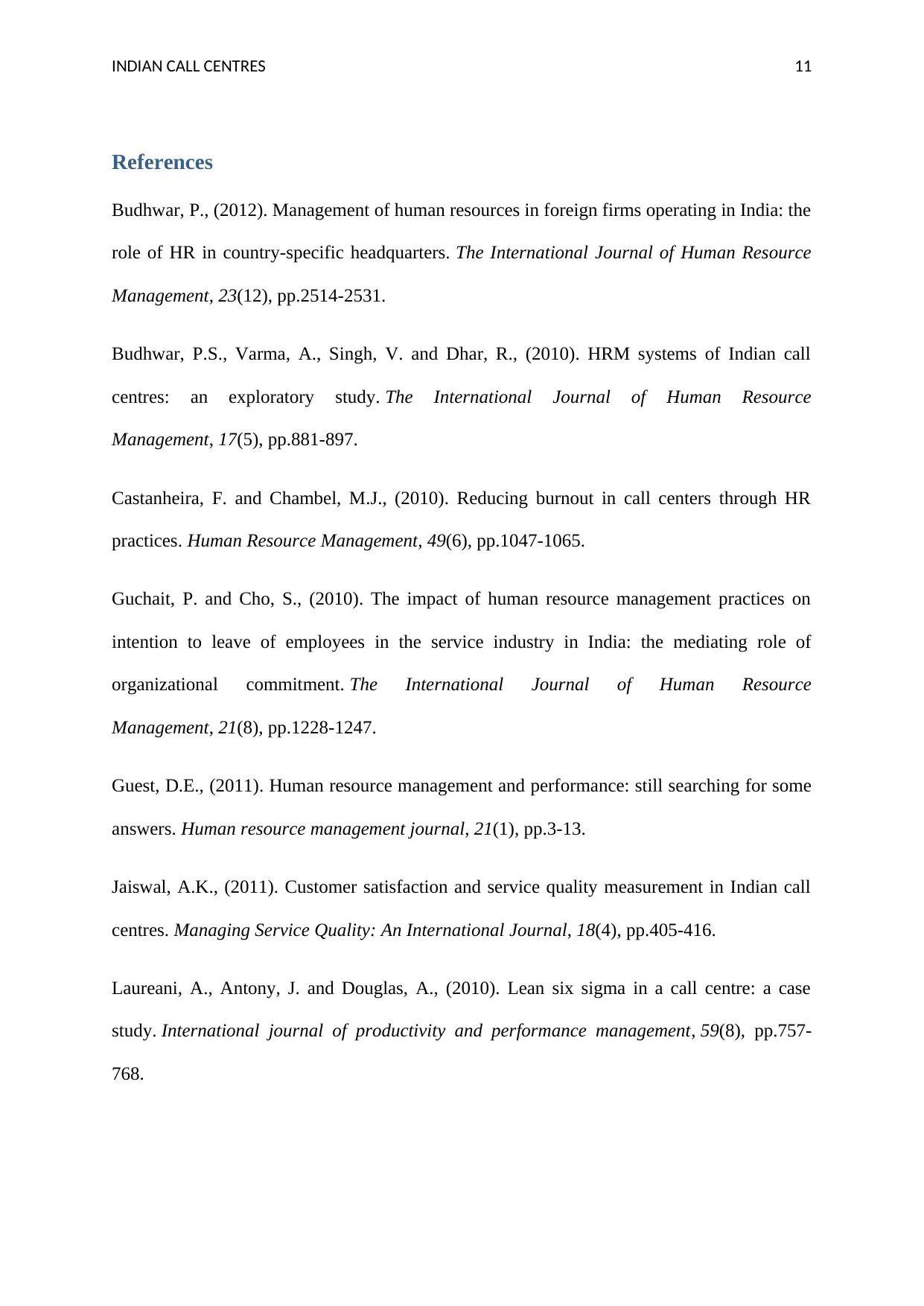
INDIAN CALL CENTRES 11
References
Budhwar, P., (2012). Management of human resources in foreign firms operating in India: the
role of HR in country-specific headquarters. The International Journal of Human Resource
Management, 23(12), pp.2514-2531.
Budhwar, P.S., Varma, A., Singh, V. and Dhar, R., (2010). HRM systems of Indian call
centres: an exploratory study. The International Journal of Human Resource
Management, 17(5), pp.881-897.
Castanheira, F. and Chambel, M.J., (2010). Reducing burnout in call centers through HR
practices. Human Resource Management, 49(6), pp.1047-1065.
Guchait, P. and Cho, S., (2010). The impact of human resource management practices on
intention to leave of employees in the service industry in India: the mediating role of
organizational commitment. The International Journal of Human Resource
Management, 21(8), pp.1228-1247.
Guest, D.E., (2011). Human resource management and performance: still searching for some
answers. Human resource management journal, 21(1), pp.3-13.
Jaiswal, A.K., (2011). Customer satisfaction and service quality measurement in Indian call
centres. Managing Service Quality: An International Journal, 18(4), pp.405-416.
Laureani, A., Antony, J. and Douglas, A., (2010). Lean six sigma in a call centre: a case
study. International journal of productivity and performance management, 59(8), pp.757-
768.
References
Budhwar, P., (2012). Management of human resources in foreign firms operating in India: the
role of HR in country-specific headquarters. The International Journal of Human Resource
Management, 23(12), pp.2514-2531.
Budhwar, P.S., Varma, A., Singh, V. and Dhar, R., (2010). HRM systems of Indian call
centres: an exploratory study. The International Journal of Human Resource
Management, 17(5), pp.881-897.
Castanheira, F. and Chambel, M.J., (2010). Reducing burnout in call centers through HR
practices. Human Resource Management, 49(6), pp.1047-1065.
Guchait, P. and Cho, S., (2010). The impact of human resource management practices on
intention to leave of employees in the service industry in India: the mediating role of
organizational commitment. The International Journal of Human Resource
Management, 21(8), pp.1228-1247.
Guest, D.E., (2011). Human resource management and performance: still searching for some
answers. Human resource management journal, 21(1), pp.3-13.
Jaiswal, A.K., (2011). Customer satisfaction and service quality measurement in Indian call
centres. Managing Service Quality: An International Journal, 18(4), pp.405-416.
Laureani, A., Antony, J. and Douglas, A., (2010). Lean six sigma in a call centre: a case
study. International journal of productivity and performance management, 59(8), pp.757-
768.
⊘ This is a preview!⊘
Do you want full access?
Subscribe today to unlock all pages.

Trusted by 1+ million students worldwide
1 out of 14
Your All-in-One AI-Powered Toolkit for Academic Success.
+13062052269
info@desklib.com
Available 24*7 on WhatsApp / Email
![[object Object]](/_next/static/media/star-bottom.7253800d.svg)
Unlock your academic potential
Copyright © 2020–2025 A2Z Services. All Rights Reserved. Developed and managed by ZUCOL.
